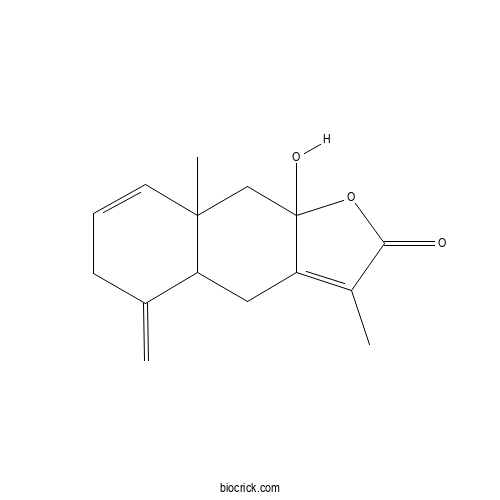HydroxylinderstrenolideCAS# 20267-92-9 |

Quality Control & MSDS
3D structure
Package In Stock
Number of papers citing our products

| Cas No. | 20267-92-9 | SDF | Download SDF |
| PubChem ID | 76046873.0 | Appearance | Powder |
| Formula | C15H18O3 | M.Wt | 246.31 |
| Type of Compound | N/A | Storage | Desiccate at -20°C |
| Solubility | Soluble in Chloroform,Dichloromethane,Ethyl Acetate,DMSO,Acetone,etc. | ||
| Chemical Name | 9a-hydroxy-3,8a-dimethyl-5-methylidene-4,4a,6,9-tetrahydrobenzo[f][1]benzofuran-2-one | ||
| SMILES | CC1=C2CC3C(=C)CC=CC3(CC2(OC1=O)O)C | ||
| Standard InChIKey | VMGUBSLDEXOUMH-UHFFFAOYSA-N | ||
| Standard InChI | InChI=1S/C15H18O3/c1-9-5-4-6-14(3)8-15(17)12(7-11(9)14)10(2)13(16)18-15/h4,6,11,17H,1,5,7-8H2,2-3H3 | ||
| General tips | For obtaining a higher solubility , please warm the tube at 37 ℃ and shake it in the ultrasonic bath for a while.Stock solution can be stored below -20℃ for several months. We recommend that you prepare and use the solution on the same day. However, if the test schedule requires, the stock solutions can be prepared in advance, and the stock solution must be sealed and stored below -20℃. In general, the stock solution can be kept for several months. Before use, we recommend that you leave the vial at room temperature for at least an hour before opening it. |
||
| About Packaging | 1. The packaging of the product may be reversed during transportation, cause the high purity compounds to adhere to the neck or cap of the vial.Take the vail out of its packaging and shake gently until the compounds fall to the bottom of the vial. 2. For liquid products, please centrifuge at 500xg to gather the liquid to the bottom of the vial. 3. Try to avoid loss or contamination during the experiment. |
||
| Shipping Condition | Packaging according to customer requirements(5mg, 10mg, 20mg and more). Ship via FedEx, DHL, UPS, EMS or other couriers with RT, or blue ice upon request. | ||

Hydroxylinderstrenolide Dilution Calculator

Hydroxylinderstrenolide Molarity Calculator
| 1 mg | 5 mg | 10 mg | 20 mg | 25 mg | |
| 1 mM | 4.0599 mL | 20.2996 mL | 40.5992 mL | 81.1985 mL | 101.4981 mL |
| 5 mM | 0.812 mL | 4.0599 mL | 8.1198 mL | 16.2397 mL | 20.2996 mL |
| 10 mM | 0.406 mL | 2.03 mL | 4.0599 mL | 8.1198 mL | 10.1498 mL |
| 50 mM | 0.0812 mL | 0.406 mL | 0.812 mL | 1.624 mL | 2.03 mL |
| 100 mM | 0.0406 mL | 0.203 mL | 0.406 mL | 0.812 mL | 1.015 mL |
| * Note: If you are in the process of experiment, it's necessary to make the dilution ratios of the samples. The dilution data above is only for reference. Normally, it's can get a better solubility within lower of Concentrations. | |||||

Calcutta University

University of Minnesota

University of Maryland School of Medicine

University of Illinois at Chicago

The Ohio State University

University of Zurich

Harvard University

Colorado State University

Auburn University

Yale University

Worcester Polytechnic Institute

Washington State University

Stanford University

University of Leipzig

Universidade da Beira Interior

The Institute of Cancer Research

Heidelberg University

University of Amsterdam

University of Auckland

TsingHua University

The University of Michigan

Miami University

DRURY University

Jilin University

Fudan University

Wuhan University

Sun Yat-sen University

Universite de Paris

Deemed University

Auckland University

The University of Tokyo

Korea University
- Regaloside E
Catalog No.:BCX1502
CAS No.:123134-21-4
- Homocapsaicin II
Catalog No.:BCX1501
CAS No.:71240-51-2
- Potentillanoside A
Catalog No.:BCX1500
CAS No.:1309589-79-4
- Swertiaside
Catalog No.:BCX1499
CAS No.:96087-14-8
- Confusarin
Catalog No.:BCX1498
CAS No.:108909-02-0
- Denthyrsinin
Catalog No.:BCX1497
CAS No.:118169-17-8
- 9-epi-6-Methoxygeniposidic acid
Catalog No.:BCX1496
CAS No.:1215178-87-2
- 12β-Acetoxycoccinic acid
Catalog No.:BCX1495
CAS No.:125247-74-7
- 11-O-Syringylbergenin
Catalog No.:BCX1494
CAS No.:126485-47-0
- 7,4'-Di-O-methyltectorigenin
Catalog No.:BCX1493
CAS No.:13186-08-8
- Ginsenoside CY
Catalog No.:BCX1492
CAS No.:83480-65-3
- ent-kauran-16β,17-diol
Catalog No.:BCX1491
CAS No.:16836-31-0
- Visamminol-3'-O-glucoside
Catalog No.:BCX1504
CAS No.:2254096-98-3
- Tetrahydrodehydrodiconiferyl alcohol
Catalog No.:BCX1505
CAS No.:5234-70-8
- Fulvotomentoside A
Catalog No.:BCX1506
CAS No.:150107-44-1
- Sarsasapogenin acetate
Catalog No.:BCX1507
CAS No.:35319-91-6
- 4'-Hydroxyflavone
Catalog No.:BCX1508
CAS No.:4143-63-9
- Isoemetine hydrobromide
Catalog No.:BCX1509
CAS No.:21026-77-7
- Isocoptisine acetate
Catalog No.:BCX1510
CAS No.:30426-66-5
- Lycoramine Hydrobromide
Catalog No.:BCX1511
CAS No.:89505-76-0
- Smilagenin acetate
Catalog No.:BCX1512
CAS No.:4947-75-5
- Rhetsinine
Catalog No.:BCX1513
CAS No.:526-43-2
- Synigrin
Catalog No.:BCX1514
CAS No.:534-69-0
- Paeoniflorgenin
Catalog No.:BCX1515
CAS No.:697300-41-7
[Simultaneous determination of three sesquiterpene lactones in Radix Linderae by HPLC].[Pubmed:20209914]
Zhongguo Zhong Yao Za Zhi. 2009 Nov;34(21):2777-80.
OBJECTIVE: To develop an HPLC method for simultaneous determination of three major sesquiterpene lactones in Radix Linderae. METHOD: The chromatographic separation was achieved on a Diamonsil C18 column (4.6 mm x 250 mm, 5 microm) using isocratic elution of acetonitrile-water (containing 0.1% H3 PO4) (45 : 55) at a flow rate of 1.0 mL x min(-1). Detection was carried out using a photodiode array detector at 220 nm. RESULT: The calibration curves were linear in the range of 0.001 8-0.036 0 g x L(-1) for Hydroxylinderstrenolide (R2 = 0.999 8), 0.016 2-0.323 2 g x L(-1) for neolinderalactone (R2 = 0.999 9), 0.010 5-0.209 9 g x L(-1) for linderane (R2 = 0.999 9), respectively. The average recoveries were 100.0% for Hydroxylinderstrenolide, 98.8% for neolinderalactone and 98.9% for linderane with RSD not more than 3.3%. CONCLUSION: The established method was proved to be simple, sensitive and credible, and can be applied to quality control of Radix Linderae.
[Studies on constituents of the leaves of Lindera aggregata (Sims) Kosterm].[Pubmed:12776349]
Zhongguo Zhong Yao Za Zhi. 2001 Nov;26(11):765-7.
OBJECTIVE: To study the antibacterial and anti-inflammatory constituents of the leaves of Lindera aggrega. METHOD: Compounds were isolated by colum chromatography, and the structures were identified by spectroscopic methods. RESULT: Six compounds were isolated and identified as mixture of 6-Acetyllindenanolide B-1 and B-2(I), dehydrolindestrenolide (II), Hydroxylinderstrenolide (III), linderalactone (IV), kameofero (V), beta-sitosterol (VI). CONCLUSION: These compounds were obtained from the leaves of Lindera aggregata for the first time.


